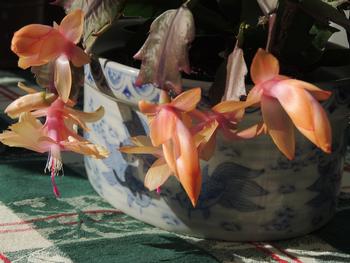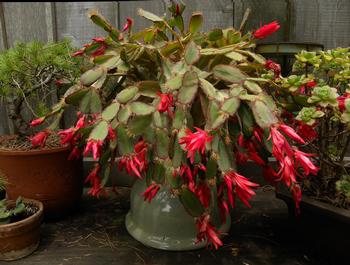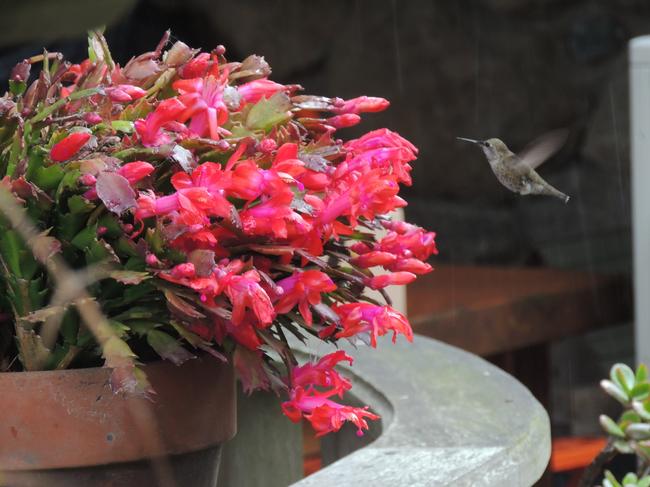Light up your house with Christmas cactus...
-
Diane Lynch
-
A few years ago I saw a Christmas cactus in Menlo Park on the shady front porch of a family who had inherited it from a grandmother. It was estimated to be about 100 years old. It was enormous! Every few years they’d re-pot, so it now resides in a large pot on a sturdy wheeled stand so they can move it to optimal conditions.
Every fall I buy a few more Christmas cacti and enjoy the bountiful, delicate blooms. Then I put them outside, neglecting proper water and light. The result is that they bloom again but don’t really look that great. So here’s what you need to know to have them last for decades: no direct midday sunlight, regular water and good drainage—no wet feet.
 Thanksgiving cactus, also known as Crab Claw Cactus, as evidenced by the little points on the stem segments.
Thanksgiving cactus, also known as Crab Claw Cactus, as evidenced by the little points on the stem segments.
Did you know that there are Thanksgiving, Christmas and Easter cacti? Each is a bit different and if you have some of each you’ll have the delightful flowers a good part of the year. Thanksgiving cactus, Schlumbergera truncata, has little points on the segments and blooms in fall. Christmas cactus, Schlumbergera bridgesii or x buckleyi, blooms a month or so later and has slightly different projections on its leaves, which are more scalloped and less pointed that the projections on the Thanksgiving cactus. Easter cactus, commonly called summer cactus. Stem segments are flatter and have tiny bristly hairs and flowers have smaller and more numerous petals.
Easter cactus, commonly called summer cactus. Stem segments are flatter and have tiny bristly hairs and flowers have smaller and more numerous petals.
Easter cactus, Hatiora gaertneri, also called summer cactus in nurseries blooms in spring or early summer. The stem segments have little prickly hairs at the joints. Hybridizers continue to create new cultivars and I’m entranced by the salmon and apricot colors, but they come in traditional white, purple, red and pink, too.Because these are native to humid jungles in the coastal mountains of Brazil, they need ample water but excellent drainage. They are understory epiphytes, which means they grow on shady tree branches or other surfaces, absorbing nourishment from the air. What look like leaves are actually modified stems that photosynthesize for the plant. During their summer bloom season (our winter months) they can receive up to 17 inches of rain a month and even in the dry season get at least 3 inches a month.
Light fertilizing is recommended monthly during the growing season, March to September. Easter or summer cactus can be fed all year except during its bloom season. When your plant is in bloom and you want to enjoy it inside keep it away from drafty heat or A/C vents. Putting gravel in the saucer and misting will keep the humidity higher. You can help your plant bloom in December by keeping it in the low 50s and controlling the light it receives to about 13 hours of darkness in September, while reducing water until buds start to form. Then increase water and temperature a bit. Most houses aren’t cool enough to make this work so well and outside temperatures are variable. Being lazy, I enjoy these ethereal beauties whenever they choose to bloom. Hummingbirds love Thanksgiving cactus and have mapping technology so they don’t waste precious energy on revisiting blossoms.
Hummingbirds love Thanksgiving cactus and have mapping technology so they don’t waste precious energy on revisiting blossoms.Like most succulents Christmas cactus and its cousins are quite easy to propagate. After flowering, break off pieces with three or more segments and let the ends dry for several days. Insert about an inch into moist potting soil. Because they like humidity it’s helpful to create a little tent with a plastic bag held in place with a rubber band. Leave the drainage holes exposed for oxygen transfer. Use chopsticks or twigs to keep the plastic off the leaves. Voila, new plants!
Enjoy your Christmas cactus, take reasonable care of it, including regular water and good drainage, not too much sun, and it's possible your grandchildren will be proudly telling people that this was their grandparents' plant and that they had to build a stand with wheels to support it!



